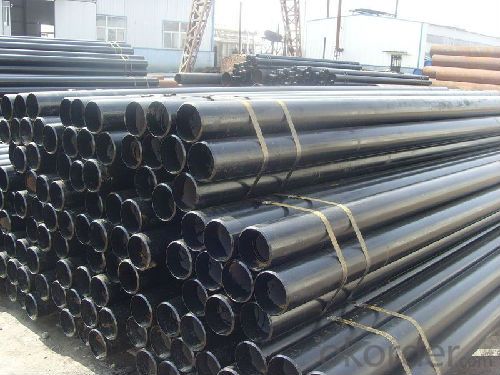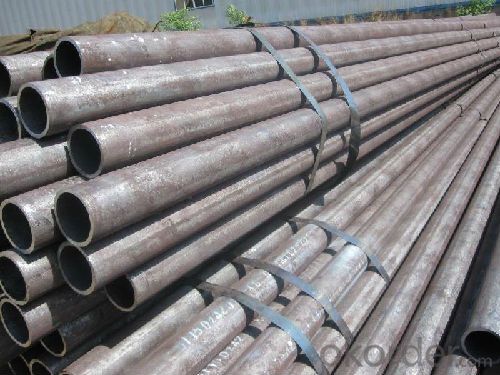Packaging & Delivery of Seamless Steel Tubes with High Quality for Sale:
| Packaging Details: | BUNDLE,PLASTIC BAG, HEXAGONAL METAL STRAPS, WOODEN CASE ,WOVEN BAG |
|---|---|
| Delivery Detail: | 15-30days |
OKorder Service Pledge
OKorder Financial Service
You Might Also Like
Product Description of Seamless Steel Tubes with High Quality for Sale:
Grade:A53-A369
Thickness:8 mm
Place of Origin:Tianjin, China (Mainland)
Secondary Or Not:Is Secondary
Technique:Seamless
Model Number:273mm*8mm
Standard:ASME, ASTM A106-2006
Specification:273mm*8mm
Outer Diameter:273mm
Length:5-12Meters
Usage:used in home application
Grade:API J55
SS steel tube 316L SS steel tube 316L API SPEC 5CT J55\K55\N80\L80\P110(LTC),(STC),(BTC) API SPEC 5L PSL 1:A25\A\B\X42\X46\X52\X56\X60\ X65 \X70 PSL 2:B\X42\X46\X52\X56\X60\X65\X70\ X80 ASTM A106 GR.A\B\C ASTM A53 GR.A\B DIN1629 JIS G3454 ASTM A192\A210\A179 DIN17175 JIS G3455 ASTM A213 JIS G3456 Application of Seamless Steel Tubes with High Quality for Sale: API SPEC 5L For the purpose of transportation of gas,water,oill in oil&gas industry. API SPEC 5CT.Tubing is used in extracting petroleum & natural gas. casing pipe serves as wall of well. ASTM A106. for the purpose of the pipeline project of boiler,water&petroleum. ASTM A53 It is used for conveying water,petrolem,gas and other common fluids. ASTM A179 For tubed heat exchanger and similar heat conveying equipments ASTM A192 For manufacture wall panel,economizer,reheater,superheater and steam pipeline of boilers. Chemical Composition STANDARD GRADE CHEMICAL COMPOSITION C Si Mn P S Cr Mo Cu Ni V ASME SA106 SA106B 0.170.25 ≥0.1 0.701.00 ≤0.030 ≤0.030 ≤0.035 ASTM A106 A ≤0.25 ≤0.10 0.270.93 ≤0.035 ≤0.035 ≤0.40 ≤0.15 ≤0.40 ≤0.40 ≤0.08 B ≤0.30 ≤0.10 0.291.06 ≤0.035 ≤0.035 ≤0.40 ≤0.15 ≤0.40 ≤0.40 ≤0.08 C ≤0.35 ≤0.10 0.291.06 ≤0.035 ≤0.035 ≤0.40 ≤0.15 ≤0.40 ≤0.40 ≤0.08 ASTM A53 A 0.25 / 0.95 0.05 0.045 0.40 0.15 0.40 0.40 0.08 B 0.3 / 1.2 0.05 0.045 0.40 0.15 0.40 0.40 0.08 ASTM A179 A179 ≤0.06-0.18 / 0.27-0.63 ≤0.035 ≤0.035 ASTM A192 A192 0.060.18 ≤0.25 0.270.63 ≤0.035 ≤0.035 ASTM A210 A-1 ≤0.27 ≥0.10 ≤0.93 ≤0.035 ≤0.035 C ≤0.35 ≥0.10 0.291.06 ≤0.035 ≤0.035 FAQ: Q1: Why buy Materials & Equipment from OKorder.com? A1: All products offered byOKorder.com are carefully selected from China's most reliable manufacturing enterprises. Through its ISO certifications, OKorder.com adheres to the highest standards and a commitment to supply chain safety and customer satisfaction. Q2: How do we guarantee the quality of our products? A2: We have established an advanced quality management system which conducts strict quality tests at every step, from raw materials to the final product. At the same time, we provide extensive follow-up service assurances as required. Q3: How soon can we receive the product after purchase? A3: Within three days of placing an order, we will begin production. The specific shipping date is dependent upon international and government factors, but is typically 7 to 10 workdays. Images:Packaging & Delivery of Seamless Steel Tubes with High Quality for Sale:
Packaging Details: BUNDLE,PLASTIC BAG, HEXAGONAL METAL STRAPS, WOODEN CASE ,WOVEN BAG Delivery Detail: 15-30days Specifications of Seamless Steel Tubes with High Quality for Sale:
273mm*8mm
5-12Meters
used in home application, construction and other purposes.
273mm*8mm
5-12Meters
used in home application, construction and other purposes


Send your message to us
OKorder Service Pledge
OKorder Financial Service
Similar products
Hot products
Hot Searches
Related keywords